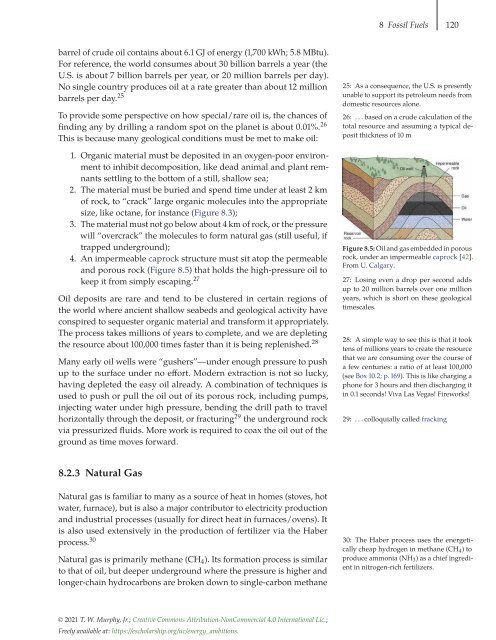Energy and Human Ambitions on a Finite Planet, 2021a
Energy and Human Ambitions on a Finite Planet, 2021a
Energy and Human Ambitions on a Finite Planet, 2021a
You also want an ePaper? Increase the reach of your titles
YUMPU automatically turns print PDFs into web optimized ePapers that Google loves.
8 Fossil Fuels 120<br />
barrel of crude oil c<strong>on</strong>tains about 6.1 GJ of energy (1,700 kWh; 5.8 MBtu).<br />
For reference, the world c<strong>on</strong>sumes about 30 billi<strong>on</strong> barrels a year (the<br />
U.S. is about 7 billi<strong>on</strong> barrels per year, or 20 milli<strong>on</strong> barrels per day).<br />
No single country produces oil at a rate greater than about 12 milli<strong>on</strong><br />
barrels per day. 25<br />
To provide some perspective <strong>on</strong> how special/rare oil is, the chances of<br />
finding any by drilling a r<str<strong>on</strong>g>and</str<strong>on</strong>g>om spot <strong>on</strong> the planet is about 0.01%. 26<br />
This is because many geological c<strong>on</strong>diti<strong>on</strong>s must be met to make oil:<br />
1. Organic material must be deposited in an oxygen-poor envir<strong>on</strong>ment<br />
to inhibit decompositi<strong>on</strong>, like dead animal <str<strong>on</strong>g>and</str<strong>on</strong>g> plant remnants<br />
settling to the bottom of a still, shallow sea;<br />
2. The material must be buried <str<strong>on</strong>g>and</str<strong>on</strong>g> spend time under at least 2 km<br />
of rock, to “crack” large organic molecules into the appropriate<br />
size, like octane, for instance (Figure 8.3);<br />
3. The material must not go below about 4 km of rock, or the pressure<br />
will “overcrack” the molecules to form natural gas (still useful, if<br />
trapped underground);<br />
4. An impermeable caprock structure must sit atop the permeable<br />
<str<strong>on</strong>g>and</str<strong>on</strong>g> porous rock (Figure 8.5) that holds the high-pressure oil to<br />
keep it from simply escaping. 27<br />
Oil deposits are rare <str<strong>on</strong>g>and</str<strong>on</strong>g> tend to be clustered in certain regi<strong>on</strong>s of<br />
the world where ancient shallow seabeds <str<strong>on</strong>g>and</str<strong>on</strong>g> geological activity have<br />
c<strong>on</strong>spired to sequester organic material <str<strong>on</strong>g>and</str<strong>on</strong>g> transform it appropriately.<br />
The process takes milli<strong>on</strong>s of years to complete, <str<strong>on</strong>g>and</str<strong>on</strong>g> we are depleting<br />
the resource about 100,000 times faster than it is being replenished. 28<br />
Many early oil wells were “gushers”—under enough pressure to push<br />
up to the surface under no effort. Modern extracti<strong>on</strong> is not so lucky,<br />
having depleted the easy oil already. A combinati<strong>on</strong> of techniques is<br />
used to push or pull the oil out of its porous rock, including pumps,<br />
injecting water under high pressure, bending the drill path to travel<br />
horiz<strong>on</strong>tally through the deposit, or fracturing 29 the underground rock<br />
via pressurized fluids. More work is required to coax the oil out of the<br />
ground as time moves forward.<br />
25: As a c<strong>on</strong>sequence, the U.S. is presently<br />
unable to support its petroleum needs from<br />
domestic resources al<strong>on</strong>e.<br />
26: . . . based <strong>on</strong> a crude calculati<strong>on</strong> of the<br />
total resource <str<strong>on</strong>g>and</str<strong>on</strong>g> assuming a typical deposit<br />
thickness of 10 m<br />
Figure 8.5: Oil <str<strong>on</strong>g>and</str<strong>on</strong>g> gas embedded in porous<br />
rock, under an impermeable caprock [42].<br />
From U. Calgary.<br />
27: Losing even a drop per sec<strong>on</strong>d adds<br />
up to 20 milli<strong>on</strong> barrels over <strong>on</strong>e milli<strong>on</strong><br />
years, which is short <strong>on</strong> these geological<br />
timescales.<br />
28: A simple way to see this is that it took<br />
tens of milli<strong>on</strong>s years to create the resource<br />
that we are c<strong>on</strong>suming over the course of<br />
a few centuries: a ratio of at least 100,000<br />
(see Box 10.2; p. 169). This is like charging a<br />
ph<strong>on</strong>e for 3 hours <str<strong>on</strong>g>and</str<strong>on</strong>g> then discharging it<br />
in 0.1 sec<strong>on</strong>ds! Viva Las Vegas! Fireworks!<br />
29: . . . colloquially called fracking<br />
8.2.3 Natural Gas<br />
Natural gas is familiar to many as a source of heat in homes (stoves, hot<br />
water, furnace), but is also a major c<strong>on</strong>tributor to electricity producti<strong>on</strong><br />
<str<strong>on</strong>g>and</str<strong>on</strong>g> industrial processes (usually for direct heat in furnaces/ovens). It<br />
is also used extensively in the producti<strong>on</strong> of fertilizer via the Haber<br />
process. 30<br />
Natural gas is primarily methane (CH 4 ). Its formati<strong>on</strong> process is similar<br />
to that of oil, but deeper underground where the pressure is higher <str<strong>on</strong>g>and</str<strong>on</strong>g><br />
l<strong>on</strong>ger-chain hydrocarb<strong>on</strong>s are broken down to single-carb<strong>on</strong> methane<br />
30: The Haber process uses the energetically<br />
cheap hydrogen in methane (CH 4 )to<br />
produce amm<strong>on</strong>ia (NH 3 ) as a chief ingredient<br />
in nitrogen-rich fertilizers.<br />
© 2021 T. W. Murphy, Jr.; Creative Comm<strong>on</strong>s Attributi<strong>on</strong>-N<strong>on</strong>Commercial 4.0 Internati<strong>on</strong>al Lic.;<br />
Freely available at: https://escholarship.org/uc/energy_ambiti<strong>on</strong>s.


















